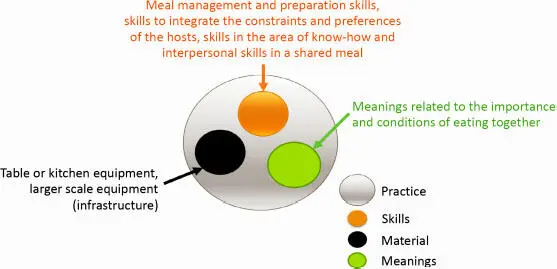– Do you cook for the others every day?
– Yes, every day and we cook a little together with my roommate because she loves to cook, so we usually start with a base of foods that we want to eat and then we assemble a lot of things, one idea and then the other, and it creates something each time! (Camille).
For others, on the other hand, it is really the time spent together that matters, and the preparation/consumption of food is far from central:
You see, for example, I have a friend who comes to eat and she knows how I work and when she comes to my house she is always the one who brings food because she knows that I get bored, so she says to me, “Here, you take care of this, this, this, and I’ll take care of the food”, so that’s fun and it’s true that my friends are starting to get to know me (Pauline).
Thus, the place given to food when eating together is one of the meanings that conditions a harmonious sharing of meals.
Similarly, another meaning that can condition the feasibility of a shared consumption time is the relationship that the commensals have with the fact of eating or not eating the same thing:
Each person helps themselves, except if it is something that is a bit boring, so we serve that, but otherwise each person does it in the order they want because there is one person who wants salad like that and the other doesn’t want it… everything is on the table and we help ourselves […]. So it’s true that he eats green salad, he can’t finish without green salad for example, and he’ll eat a dessert, either yoghurt or something… a dessert (Roxane).
In this case, we can see that, for Roxane and her partner, eating together does not necessarily mean eating exactly the same thing. Conversely, Myriam feels “frustrated” that her partner does not have the same tastes as she does, and this taints their family practice of eating together : “– Cooking vegetables is easy. – If you don’t do it, it’s because of other people’s tastes, right? – Yes, that’s it, in fact I’m frustrated at home” .
These questions are particularly topical nowadays, because of the individualization of food, with more and more special diets (gluten-free, vegetarian, lactose-free, etc.). For example, in order to respect the meanings associated with the family meal, some vegetarians make exceptions to their diet and eat meat. Paola bends her vegetarian diet during family meals to avoid being the target of questioning and to avoid being forced to justify herself. Thus, for her, the meeting with her companions takes precedence over her personal values: rather than not eating meat for the sake of animal welfare, she prefers to get along with her family during meals. Similarly, Camille explains that she never forces herself to eat, except when she is at other people’s houses: “I know that grandma serves you and if you don’t finish the plate she gets the impression that it’s not good, it’s very stupid, but you know that you have to finish, but it doesn’t happen to me often” (Camille) . In this case, sharing a meal means honoring the dish that has been prepared and served by the host.
1.5. Interactions between materials, meanings and skills: particular practices or means of overcoming constraints
The previous section presented the elements (material, meanings, skills) one after the other, in order to describe their nuances and specificities. However, according to the framework of practice theories, it is the combination of these three elements that allows a practice to exist. This section therefore illustrates cases of interaction between the elements: when the interaction between the elements allows for the emergence of particular practices (such as convivial festive consumption), and when the interaction between the elements allows for the removal of constraints to eating together .
Skills and meanings can be closely linked in a festive eating together practice, in which the guests (and usually the host) demonstrate specific skills, which are at the heart of the eating together practice: this is, for example, the case for meals in which the objective is to discover or showcase a recipe and the dish is a major topic of discussion during the meal. In the same way, the esthetics of the table stands at the border between the material (e.g. beautiful dishes) and the meanings: welcoming well implies “pulling out all the stops”:
– I’m a fan of plates, glasses, cups and all that, it’s part of it, I love it, even for Elliott, I love children’s things and all that, so it’s part of the pleasure of the table.
– It goes to the point of making little presentations? Yes, when we do… well, not every day, let’s relax (laughs), but when we have friends over,
– yes, I do it. Before I knew Eliott I used to do it a lot, but now […] I do it a little less, I do it mostly when we have friends coming over, that’s it, to make a nice table I like everything that is, contrary to this drawing, everything that is mismatched, mismatched plates, I love everything that is a little vintage, 60s, a lot of stuff in that style, Scandinavian stuff, that’s it, I like everything related to crockery… (Roxane).
Thus, we see that the material can be seen as a basic constitutive element, but that there is a very wide range of material around eating together , in response to particular meanings and skills.
From the perspective of supporting the emergence or maintenance of eating together , it is also interesting to understand how the interactions between the elements that make up the practices make it possible to overcome certain constraints eating together encounters . Indeed, it may be relevant to target the elements according to this hierarchy. Material constraints, which can be considered central to the deployment of a practice, can, for example, be circumvented when the practice can call upon meanings and skills that are already in favor of eating together :
– But you see, when we were in the castle, there must have been 15 of us, now there are a few less.
– And where do you do it?
– Well, in the living room.
– Do you have a table?
– Yes, but it’s a low table, so we eat sitting on the floor with plates, but there you go (Marion).
On the other hand, material conditions that are in favor of eating together (e.g. sufficient dedicated space) can be ignored when meanings and skills do not support eating together . The driving forces or the obstacles to eating together seem to depend more on the meanings, in the face of which the skills are called upon to get around any material obstacles. This leads to the next section, which discusses the constraints that can work against eating together .
Organizational constraints can indeed complicate the fact of eating together . However, in some cases, organizational skills, carried by the meanings in favor of eating together , can counteract these constraints:
Cecile has to get up at 6:00, I have to get up at 6:30… so she has time to do a bike session or a little bit of gym activity, something like that. Then she goes for a shower and I take over there on the bike, and when I go to wash up she takes over in the kitchen, usually to prepare something [for lunch and breakfast], and usually when I get out of the shower I give her the final bit of help, then we eat (Thibaut).
We can thus say that eating together is a complex practice that solicits the constituent elements of practices at various levels ( Figure 1.3).

Figure 1.3. Summary of the components involved in the implementation of eating together. For a color version of this figure, see www.iste.co.uk/seredelanauze/evolution.zip
Читать дальше













